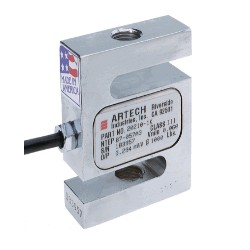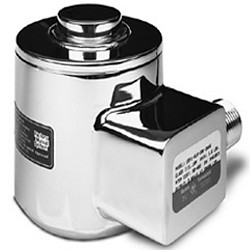You can step on a scale at the doctors office or buy fresh produce off a scale at the farmers market. Either way the scale you are looking at includes a load cell inside. But, how exactly does that load cell work? What does a load cell do? How does a load cell send weight data to a digital weight display? Let’s find out.
What is a Load Cell?
For our example, we are going to focus on the most common load cell which is the strain gauge cell. A strain gauge load cell is a type of device used to measure weight or force. It is commonly used in a variety of applications, such as weighing scales, process control automation, and testing and measurement. The load cell works by converting a force, such as the weight of an object, into an electrical signal that can be measured and send weight data to a computer.
There are several types of strain gauge load cells. This type of load cell consists of a small metal beam or rod, often made of aluminum or alloy steel, which is attached to a base. The beam is designed to flex or bend slightly under the weight or force applied to it.

How Do Load Cells Work?
At the heart of the strain gauge load cell is a thin, flexible strip of material called a strain gauge. The strain gauge is attached to the beam in a specific pattern, known as a Wheatstone bridge configuration. When the beam is subjected to a force, it will flex or bend slightly, causing the strain gauge to stretch or compress. This change in the length of the strain gauge results in a change in its electrical resistance.
The change in resistance is measured using a Wheatstone bridge circuit, which consists of four resistors arranged in a specific configuration. The strain gauge is connected to one of the resistors in the circuit, and as the strain gauge stretches or compresses, the resistance of the circuit changes.
The electrical signal produced by the load cell is proportional to the weight or force applied to the beam. The signal is then sent to a digital readout device, such as a panel mount scale controller, which displays the weight or force being measured. Another way of describing this process would be basically load cells convert tension or compression into an output signal. This output is then transmitted through the load cell cable to a digital scale display.
There are several factors that can affect the accuracy of a strain gauge load cell, including temperature, humidity, and mechanical stress. To ensure accuracy, load cells are often calibrated using known weights or forces, and the electrical signals produced by the load cells are compared to the known values. Any discrepancies between the two can be used to adjust the load cell to improve its accuracy.
A strain gauge load cell is a device used to measure weight or force by converting it into an electrical signal. It consists of a beam or rod attached to a base, with a strain gauge attached. The change in the resistance of the strain gauge caused by the slight flexing or bending of the beam and the resulting electrical signal is sent to a digital readout. Strain gauge load cells are used in a variety of applications and are highly accurate and fairly reliable, although they must be calibrated to ensure accuracy.

How Many Load Cells Do Scales Have?
Smaller scales typically have one load cell. This would include counting scales, bench scales, portion scales, etc… Larger scales like floor scales, veterinary scales, and drum scales typically have (4) load cells. Truck Scales typically have somewhere around (8) load cells. When you have four or eight load cells in one scale, often scales will include junction boxes with summing boards. These summing boards allow all the load cells to be wired up and adjusted individually. Then, a load cell cable is connected from the summing board and wired to the digital weight indicator.
Where are Load Cells Inside a Scale?
Load Cells are generally in the center of counter top scales, like counting scales or portion scales. On a platform scale, there are usually four load cells, one in each corner. On a truck scale, typically there are eight to ten load cells, evenly spaced down each side of the weighbridge.
What Replacement Load Cells for Scales Do You Recommend?
We recommend using reputable load cell brands such as Vishay Revere Transducers, Sensortronics, Tedea Huntleigh, Artech, Rice Lake, and Coti Global. There are others but as you can imagine, many imported cells have varying levels of quality, reliability, and durability. Sticking with the load cell manufacturers above is generally a smart move.